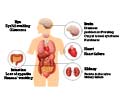A new discovery about about amyloids may open up a potential new area for therapeutics.
A new discovery about about amyloids may open up a potential new area for therapeutics. Amyloid is the fibrous protein deposits associated with diseases such as Alzheimer's and Parkinson's.
It was believed that amyloid fibrils - rope-like structures made up of proteins sometimes known as fibres - are inert, but that there may be toxic phases during their formation which can damage cells and cause disease.But in a paper published today [04 December 2009] in the Journal of Biological Chemistry, scientists at the University of Leeds have shown that amyloid fibres are in fact toxic - and that the shorter the fibre, the more toxic it becomes.
"This is a major step forward in our understanding of amyloid fibrils which play a role in such a large number of diseases," said Professor Sheena Radford of the Astbury Centre for Structural Molecular Biology and the Faculty of Biological Sciences.
"We've revisited an old suspect with very surprising results. Whilst we've only looked in detail at three of the 30 or so proteins that form amyloid in human disease, our results show that the fibres they produce are indeed toxic to cells especially when they are fragmented into shorter fibres. "
Amyloid deposits can accumulate at many different sites in the body or can remain localised to one particular organ or tissue, causing a range of different diseases. Amyloid deposits can be seen in the brain, in diseases such as Parkinson's and Alzheimer's, whereas in other amyloid diseases deposits can be found elsewhere in the body, in the joints, liver and many other organs. Amyloid deposits are also closely linked to the development of Type II diabetes.
Professor Radford said: "Problems in the self-assembly process that results in the formation of amyloid are a natural consequence of longer life. In fact 85 per cent of all cases of disease caused by amyloid deposits are seen in those over the age of sixty or so."
Advertisement
The next stage of this work is to look at a greater number of proteins that form amyloid fibres in order to consolidate these findings, says co-author and cell biologist Dr Eric Hewitt. "What we've discovered is fundamental and offers a whole new area for those working on therapeutics in this area. We anticipate that when we look at amyloid fibres formed from other proteins, they may well follow the same rules."
Advertisement
"It may be that because they're smaller it's easier for them to infiltrate cells," says Dr Hewitt. "We've observed them killing cells, but we're not sure yet exactly how they do it. Nor do we know whether these short fibres form naturally when amyloid fibres assemble or whether some molecular process makes them disassemble or fragment into shorter fibres.These are our next big challenges."
Source-Eurekalert
RAS










